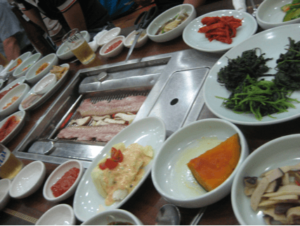The food in South Korea is very different and takes time to enjoy it. When I first moved into my apartment in Seoul, I hardly bear to open the refrigerator door for fear of the aroma that would pour out and linger in the room for an uncomfortably long period of time.
Fortunately enough, I would soon become very familiar with the stench of Korea’s national dish, kimchi. There are a few variations on this delicacy. The basic idea is white cabbage with hot chili pepper paste, soaked in vinegar and left to ferment for several days in enormous clay pots.
It is reportedly good for digestion and very high in vitamin C.
For many, this dish acquired a taste, but if you are eating a truly Korean diet it will be served at 3 meals a day, every day, and you will learn to distinguish homemade from store-bought, which ratios of garlic and chili pepper you prefer, and so on.
Personally, I wasn’t too enthusiastic at first, after a little while, I learned to love it, to the point that I now make it at home in New York City.
The other food that is present at every single Korean meal is rice. In Korean, the same word that means “rice” also means “meal,” it’s that important. It is mostly white rice and you will be very glad for it to dissipate the spice of the chili peppers if you are a kimchi novice.
One of the most popular meals among foreigners is galbi. You grill lean pork at your table and wrap up in lettuce with some garlic and sauce to taste. With a beer, this usually runs about $10-15 per person. Koreans are very social diners. It may be hard to get service at a galbi restaurant if you go alone.
The same goes for fried chicken restaurants, which serve beer and large plates of chicken with different sauces and seasonings. They are about at the same price range as galbi restaurants and offer the same atmosphere.
Another option that’s a bit cheaper is a kimbap restaurant. These are very informal, open really late, and serve cheap, quick food. You can get a big bowl of spicy ramen with egg for just a few dollars, or a kimbap roll, which is akin to sushi rolls, but there is no raw fish involved.
Instead, the inside has a strip of ham, cooked egg, carrot, and radish, with rice around it and wrapped in seaweed- tasty and only a couple of dollars.
Cheaper yet are convenience stores. These are 24 hours and have instant noodles you can make with hot water, as well as a variety of snacks and drinks. Many also have plastic tables and chairs in or outside them where you can sit down and eat or have a beer- by the way, it’s legal to drink in public.
As foreign restaurants go, there are a lot of sushi restaurants that tend to serve mostly sashimi. American-style fast-food exists too, but hamburgers are more expensive than in the U.S. and on the whole not quite as tasty. Pizza is also popular, as everywhere, but of course, there is a Korean twist on it.
When I polled my students, some of their favourite toppings included squid rings, corn bits, walnuts, and barbeque sauce, with a mashed sweet potato-filled crust. And pizza is always served with a side of sweet pickles for some reason.
In my opinion, these crazy combinations actually taste pretty good but be warned, because it’s probably not what you were expecting from pizza.
There are a couple of things rather shocking foods that you can eat in Korea and perhaps Korea alone. One is dog meat, often served as a spicy stew.
Though these dogs are raised on farms for the purpose of eating and are so ferocious-looking they bear little resemblance to the animals we keep as pets, many foreigners have a hard time with the ethics involved with this meal
. If this is how you feel, don’t worry, it’s not terribly common so it’s easily avoided.
If you’ve seen the Korean movie Old Boy, you’re probably wondering about one particular delicacy. If you haven’t seen the film, I’m talking about octopus tentacles so fresh that they are still squirming.
I was once graciously invited on a boat trip with some colleagues, during which a live octopus was caught and swiftly beheaded, and the moving tentacles served with a little spicy dipping sauce.
The sensation and texture are the crux of the experience because they taste mild (slightly of ocean) but be sure to chew thoroughly so the suckers don’t attach to your insides on the way down.
One problem I faced when I moved to Korea was that I was a staunch vegetarian. It is possible to maintain vegetarianism and probably veganism if you’re very careful, but it’s not easy.
This has not become a trend in Korea as it has in the west and I had a very tough time explaining it to most Koreans, including at restaurants.
Though tofu is commonly used, it’s often just an addition to meat or fish, not a stand-alone dish.
Finally, traditional Korean restaurants don’t have chairs so grab a cushion and get used to sitting on the floor while you eat. Also, practice using chopsticks and a spoon.
The custom is for many small dishes to be put on the table usually accompanied by soup and some meat or fish entrée, as shown in the picture included a galbi meal.
It all comes at once and you don’t get your own dish or bowl, everyone just sticks their chopsticks in whichever dish they want a bite of. It’s another way Koreans show the spirit of community, by really sharing everything on the table.
And don’t worry, you aren’t expected to clean the plates, it’s considered a sign of hospitality that more food appears on the table than you could possibly eat.
-Sonia completed OnTESOL’s 100-hour online TESOL certificate course.
Related Articles:
Teaching English in South Korea






